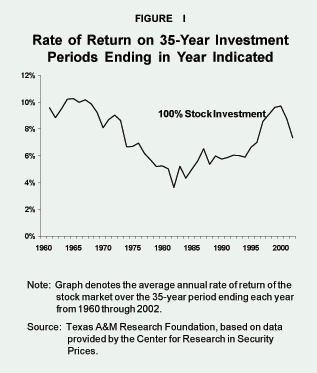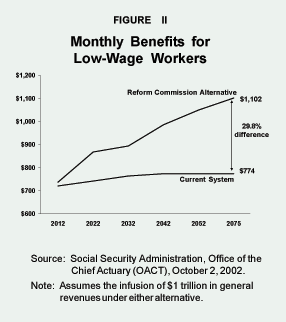Social Security reform is one of the nation's most prominent domestic policy issues. A common feature of many leading Social Security reform plans is that they would prefund benefits by integrating personal retirement accounts into the current system. Personal accounts would allow younger workers to invest some of their Social Security taxes in stocks and bonds, which would earn a compounded rate of return over the worker's life and supply a portion of the worker's retirement benefit.
Critics of personal accounts say the stock market is too risky for retirement savings. They also claim workers will fare better with today's pay-as-you-go Social Security than with personal retirement accounts. But they are wrong.
Is the Stock Market Risky?
Stock markets have been volatile in recent years. The Dow Jones Industrial Average of major corporate stocks was as high as 12,000 in 1999, but fell below 8,000 last year, a five-year low. The average share price of tech-heavy NASDAQ stocks fell about 40 percent and is near a six-year low.
While the market is volatile from day to day and sometimes year to year, over longer periods the market trends upward. A worker saving for retirement will typically invest for 35 to 40 years or more. Using data from the Center for Research in Security Prices at the University of Chicago, we can calculate the return on $1 invested each month plus reinvested earnings for any 35-year period:
- The average annual real rate of return over each of the 35-year periods ending between 1961 and 2002 was 7.3 percent after inflation. [See Figure I.]
- The lowest earning 35-year period, which ended in 1982, generated a 3.6 percent average annual real rate of return.

Thus even over the leanest recent 35-year period, investors would have gained. In fact, throughout the 20th century, investments that tracked a broad stock market index would have been profitable. An analysis of return on investment in Standard and Poor's 500 Index by economists at the Texas A&M Research Foundation shows:
- Over any 35-year period ending between 1872 and 2000, the market provided an average annual return of 6.4 percent after inflation.
- There were positive gains in every 35-year period and each outperformed what Social Security will pay in return for workers' payroll taxes.
What Happens to Workers Who Retire in a Down Year?
Even if a worker retires during a sluggish market year, the compounded value of all the gains will more than offset the losses.
For example, the market declined by roughly 43 percent between January 1973 and September 1974. Imagine a worker who retired in 1974, having saved and invested each year of his 35-year working life in a balanced, diversified portfolio. According to Texas A&M Research Foundation data, this worker would have averaged a 6.2 percent return each year.
Critics suggest that if personal retirement accounts had been invested during the late-1990s market peak, they would have lost tens of millions of dollars. They claim this would have put retirees' security at risk. But are they correct? Imagine a worker retiring in 2002 who invested over his entire working life in a broad, diversified portfolio:
- The market has declined by about 40 percent since 1999.
- However, our hypothetical investor would have earned an average annual return of 7.3 percent on his investment because of the higher returns in other years over his 35-year working life.
Of course, personal accounts need not be invested in stocks. Workers could instead invest in government or corporate bonds, which hold less risk but yield smaller returns.
Can Inexperienced Investors Be Protected?
If account holders invest in broad, diversified portfolios that reflect the market as a whole – and stay the course over their entire working lives – they can expect to gain by doing so. We can help workers who are inexperienced investors to properly diversify their accounts and avoid undue risk or unwise investments.
Most reform plans would limit workers' options. Workers would not pick and choose individual stocks. Like many 401(k) retirement plans, workers would choose between a limited number of competing, pre-constructed broad-based portfolios, managed by a professional fund manager.
Is the Current System More Dependable than Personal Retirement Accounts?
The most prominent Social Security reform plan is one of the three options proposed by President George W. Bush's Social Security reform commission. The commission's plan would allow workers to invest 4 percentage points of their Social Security payroll taxes in an individual account, up to $1,000 per year. If the account earns a minimal 2 percent average real rate of return each year, the account holder would receive a pension equal to that of today's retirees, adjusted for inflation. If the account earns more, the worker gets a bonus.
A recent analysis by the Social Security Administration's independent Office of the Chief Actuary found that a personal account plan like the commission's would pay higher benefits than the current system. However, the current system cannot pay all the benefits promised, even if it receives the same general revenue transfers required under the commission's plan to fund the transition to personal accounts – about $1 trillion in present value dollars. In most cases, low-wage workers in particular would earn substantially higher benefits than the current system promises, and much more than the current system can afford to pay. Low-income workers entering the workforce today could expect benefits up to 25 percent higher from the commission's personal account proposal than from the current program. [See Figure II.]
Conclusion
Over the long term, stock market investment can provide the foundation for a safe and secure retirement. Over the lowest-earning 35-year period in history, the market's average annual rate of return was 2.7 percent per year. Even workers retiring in a year equal to this worst-of-times scenario would receive benefits greater than the current Social Security system can afford to pay them.
Matt Moore is a policy analyst with the National Center for Policy Analysis.